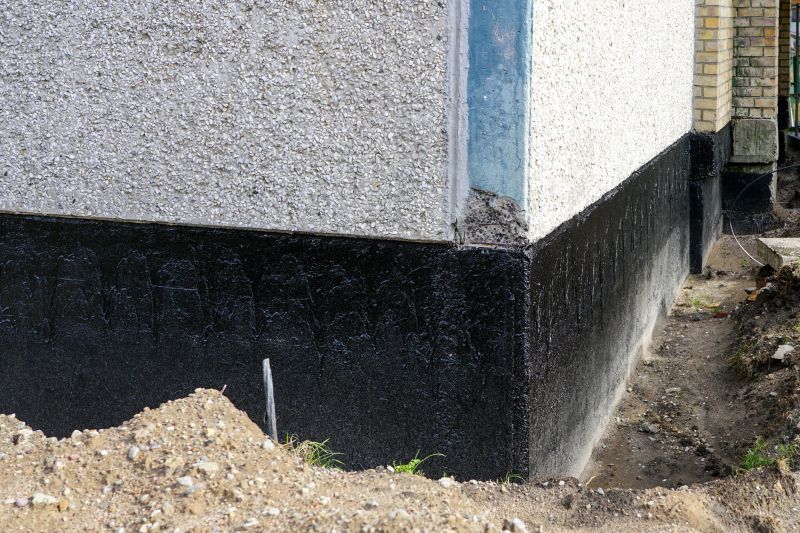Top Waterproofing Products for Reliable Moisture Protection
Explore the leading waterproofing solutions designed to safeguard structures from water damage and ensure durability.
 Waterproofing products are essential for protecting structures from water intrusion and damage. Whether safeguarding basements, roofs, foundations, or other surfaces, selecting the right waterproofing solutions can significantly extend the lifespan of a building. Proper application and maintenance of these products help prevent issues like leaks, mold growth, and structural deterioration. In Painesville, OH, where seasonal weather variations can challenge building integrity, choosing effective waterproofing materials is particularly important.
Waterproofing products are essential for protecting structures from water intrusion and damage. Whether safeguarding basements, roofs, foundations, or other surfaces, selecting the right waterproofing solutions can significantly extend the lifespan of a building. Proper application and maintenance of these products help prevent issues like leaks, mold growth, and structural deterioration. In Painesville, OH, where seasonal weather variations can challenge building integrity, choosing effective waterproofing materials is particularly important.
Top Overall Option
Liquid Waterproofing Membrane
Liquid waterproofing membranes are versatile and easy to apply, forming a seamless barrier over various surfaces. They are suitable for roofs, foundations, and balconies, providing a flexible yet durable layer of protection. These products typically cure to create a water-resistant surface that can accommodate slight movements in the substrate. When properly applied following manufacturer instructions, they can serve as an effective component in a comprehensive waterproofing system.
Types of Products For Waterproofings
Bituminous Coatings
Thick, tar-like coatings ideal for foundations and roofs, providing a durable water barrier.
Liquid Rubber Membranes
Flexible liquid coatings that cure to form seamless, waterproof layers suitable for various surfaces.
Polyurethane Sealants
High-performance sealants used to fill cracks and joints, preventing water ingress.
Cementitious Waterproof Coatings
Waterproof cement-based coatings that are easy to apply on concrete and masonry surfaces.
Bitumen Sheets
Self-adhesive or torch-applied sheets used for foundation and roof waterproofing.
Polyethylene and PVC Membranes
Sheet membranes used in roofing and subterranean applications for reliable waterproofing.
Spray-On Waterproof Coatings
Spray-applied products offering quick coverage for large surface areas, suitable for various substrates.
Crystalline Waterproofing
Chemical treatment that penetrates concrete to form a water-resistant crystalline structure.
Asphalt Emulsions
Water-based asphalt coatings suitable for roofing and foundation waterproofing.
Sealant Tapes
Self-adhesive tapes used to seal joints, cracks, and overlaps in waterproofing systems.
Drainage Boards
Protective panels that facilitate water drainage and protect waterproof layers.
Waterproofing Paints
Coatings that can be painted onto surfaces to provide a basic water-resistant barrier.
Popular Choices
Widely used for their ease of application and seamless coverage, suitable for various surfaces.
Commonly selected for foundational and roofing projects due to their proven durability.
Popular for sealing joints and cracks in concrete and masonry structures.
Favored for their flexibility and long-term water resistance in roofing systems.
Chosen for concrete structures requiring deep penetration and long-lasting protection.
Preferred for rapid application over large areas and irregular surfaces.
Commonly used in basement and tunnel waterproofing for their ease of use and compatibility.
Frequently used for quick sealing of joints and overlaps in waterproofing layers.
Often incorporated into foundation waterproofing to improve water management.
Selected for minor repairs and surface coatings where basic water resistance is needed.
There are numerous types of waterproofing products available, each designed for specific applications and surfaces. From liquid sealants to membrane systems, the variety ensures that property owners and contractors can find options suited to their unique needs. Understanding the differences between these products, along with their proper use, can lead to more successful waterproofing projects.
Applying waterproofing solutions requires attention to surface preparation, environmental conditions, and product compatibility. Proper surface cleaning, priming, and adherence are critical steps to ensure optimal performance. Additionally, considering the longevity and maintenance requirements of each product can help in making informed decisions that align with long-term goals.
In Painesville, Ohio, where weather fluctuations can impact building materials, selecting durable and reliable waterproofing products is key. Consulting with local suppliers or professionals can provide insights into products that perform well in regional conditions. Ultimately, investing in quality waterproofing materials and techniques can help protect properties from water-related issues and preserve their structural integrity over time.
Key Buying Considerations
- Identify the specific surface or structure that requires waterproofing to select the most suitable product type.
- Consider the environmental conditions, including temperature fluctuations and moisture levels, which can influence product performance.
- Evaluate the compatibility of the waterproofing material with existing surfaces and materials.
- Determine the ease of application and whether professional installation is recommended or required.
- Assess the durability and expected lifespan of the product to ensure long-term protection.
- Check for flexibility, especially for surfaces that may experience movement or expansion.
- Review curing times and drying periods to plan project timelines effectively.
- Consider the maintenance requirements and ease of reapplication if necessary.
- Look into the product’s resistance to UV exposure, chemicals, and other environmental factors relevant to your location.
- Ensure the product complies with local building codes and safety standards.
- Compare costs, but prioritize quality and suitability over price alone.
- Read product labels and technical data sheets for detailed specifications and application instructions.
- Seek advice from local suppliers or waterproofing professionals familiar with regional conditions.
- Test a small area if possible before full application to verify compatibility and performance.
- Plan for proper surface preparation, including cleaning and priming, to maximize effectiveness.
